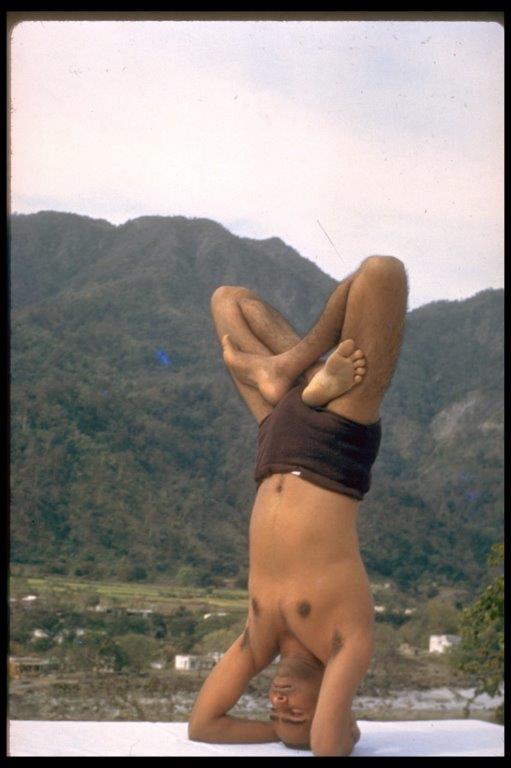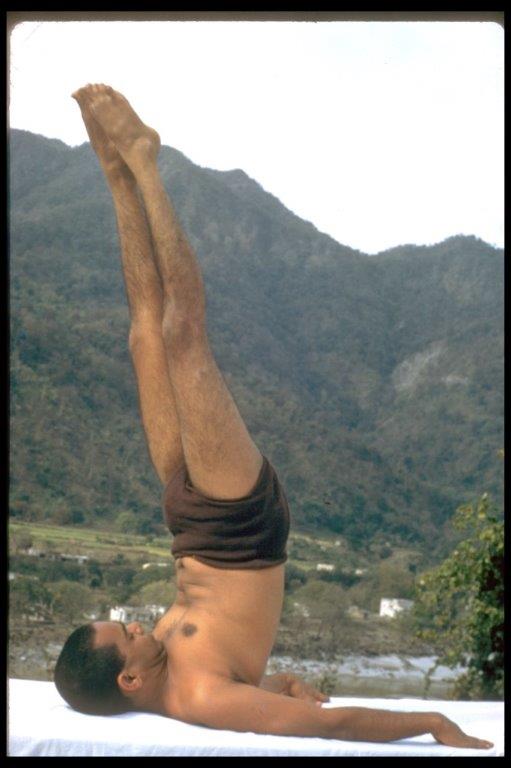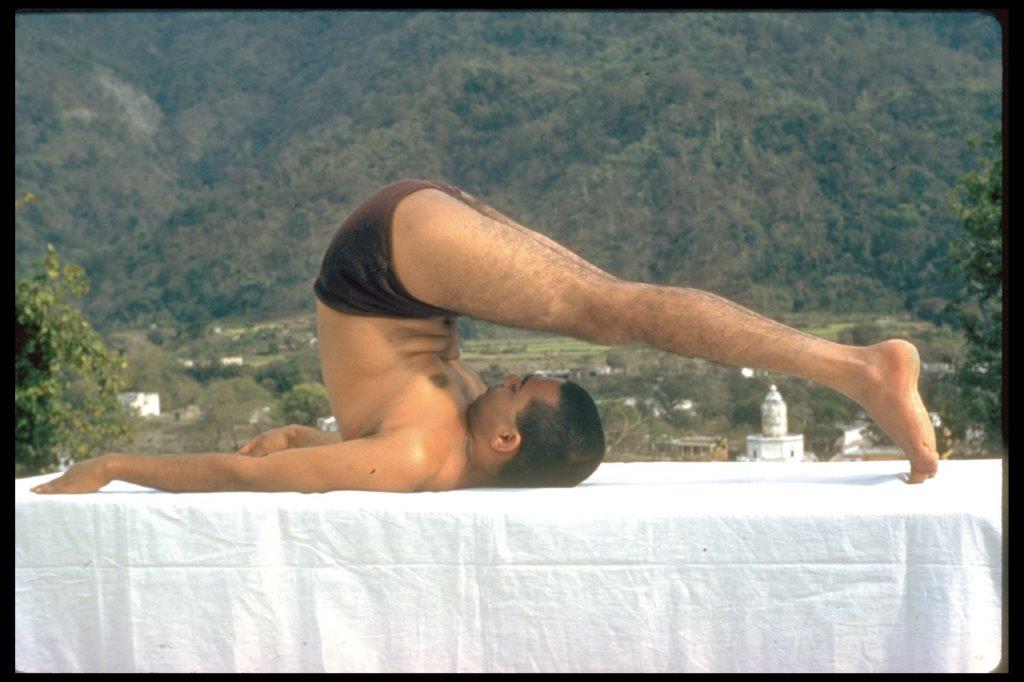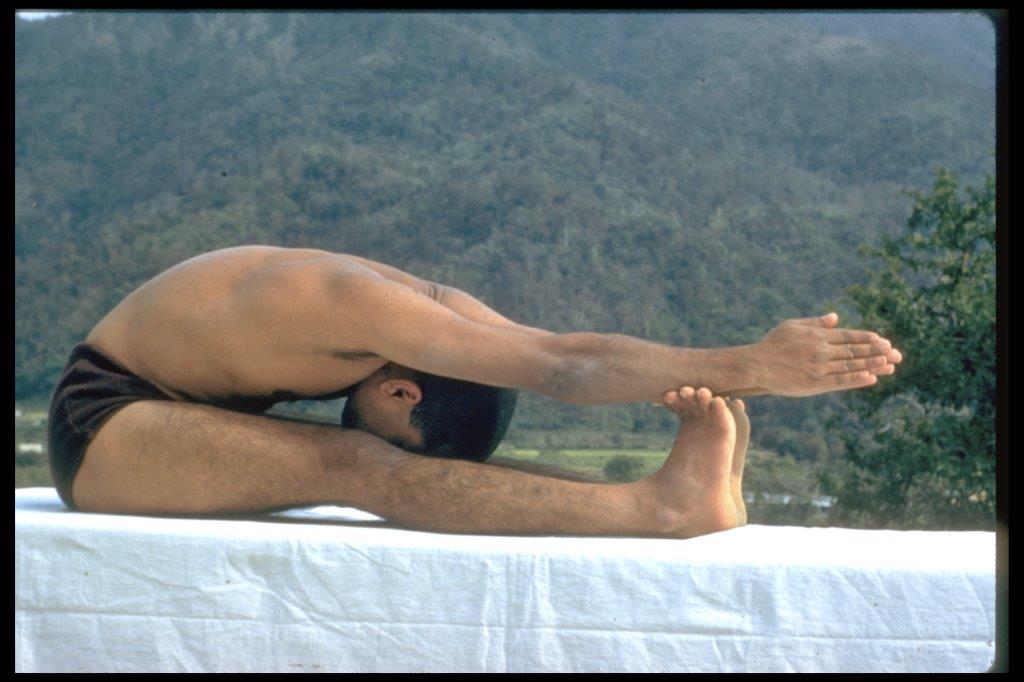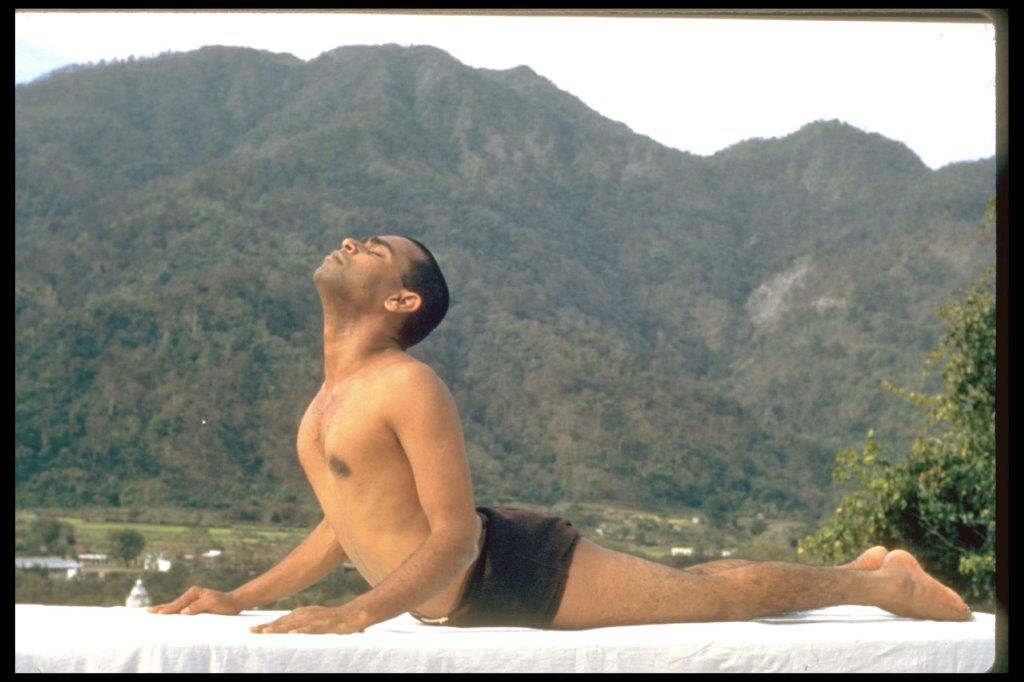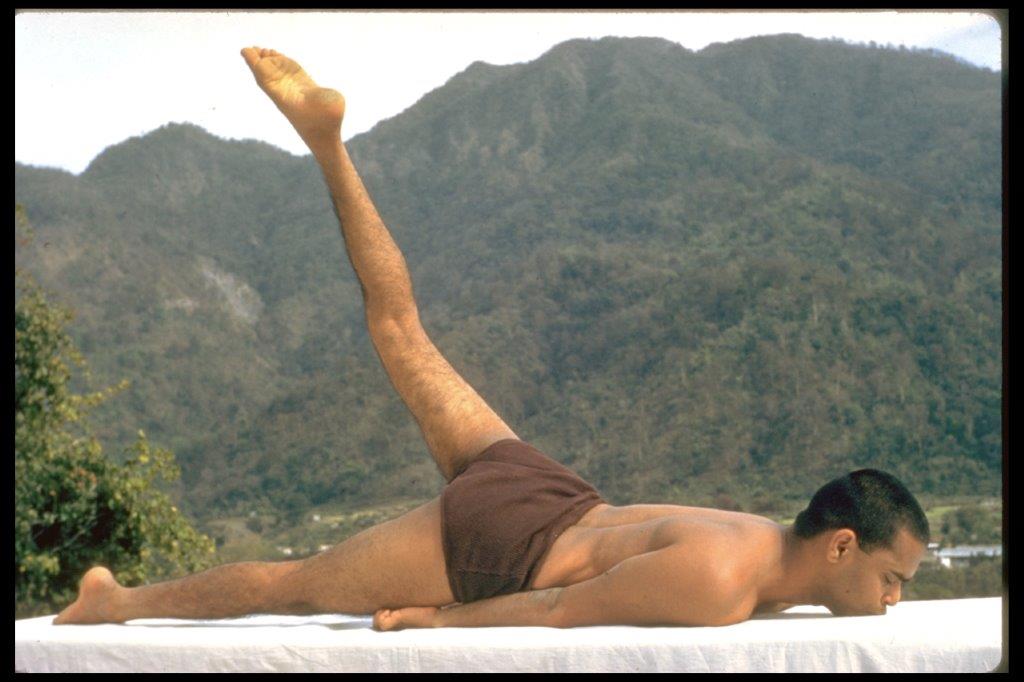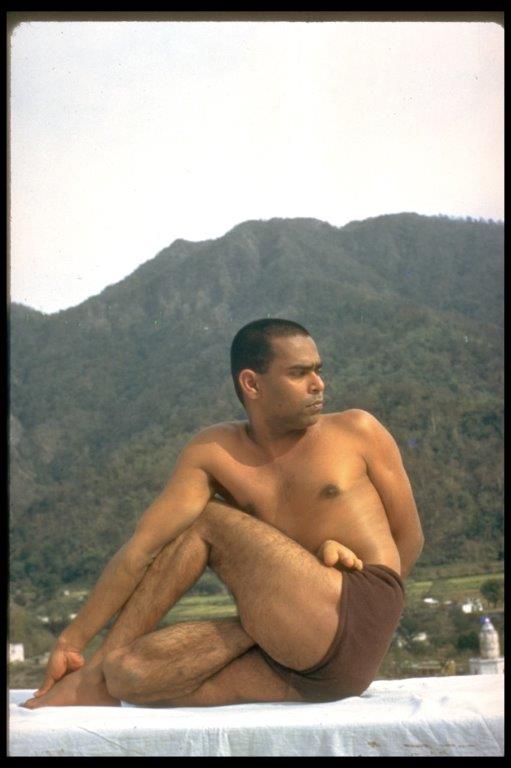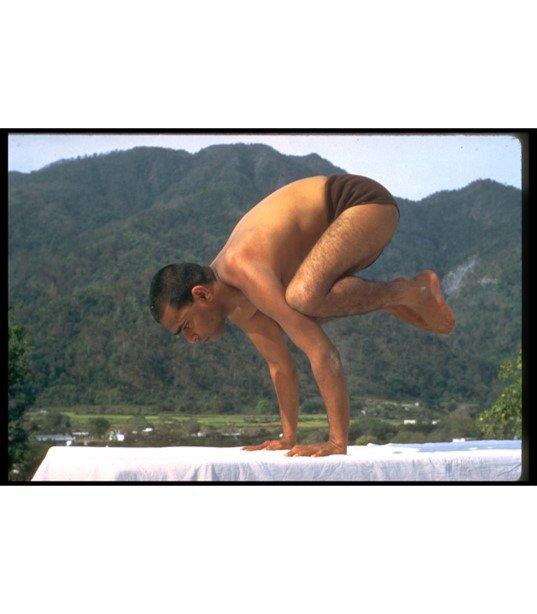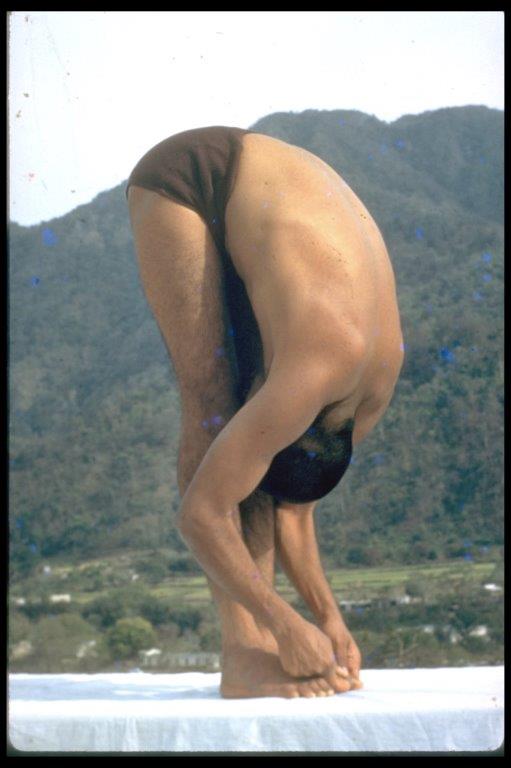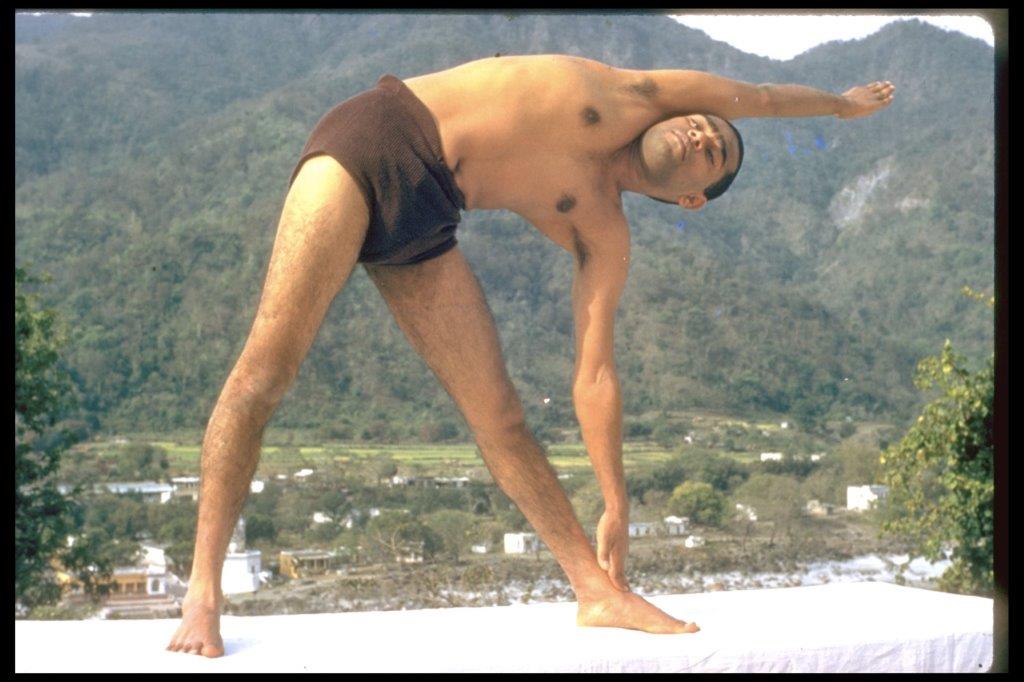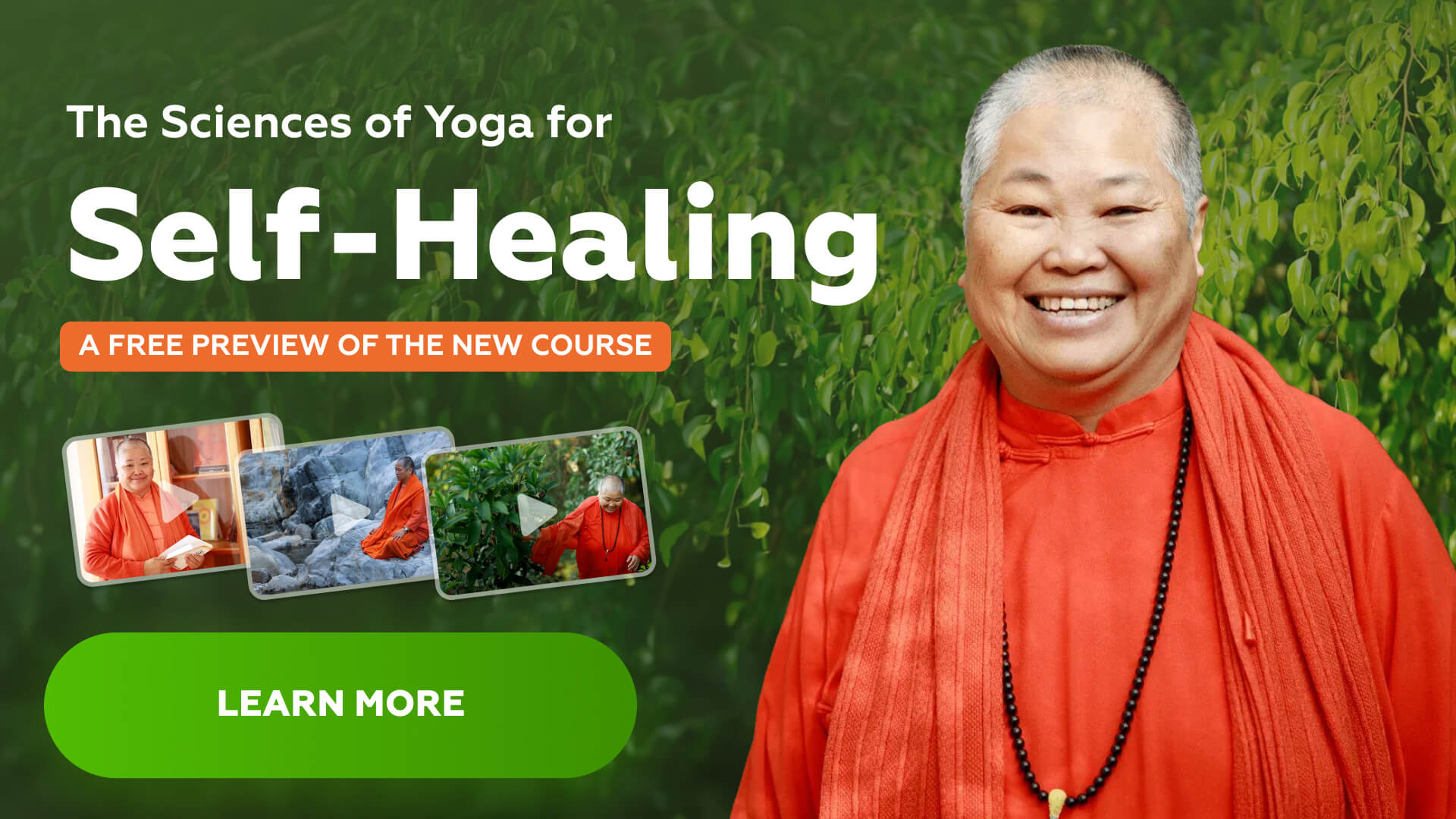YOGA POSES
What is the structure of a basic Sivananda Yoga Class? | What are some guidelines to follow? | What are the benefits of the yoga poses?
The contents on these Our Teachings webpages are reproduced from the book “Essentials of Yoga Practice and Philosophy” compiled by Swami Sitaramananda.
Below is a testimonial for this book.
A concise guide to Yoga in all of its aspects, healing, mantra, pranayama, asana and meditation as taught by one of the most important Yoga lineages of the modern world, Essentials of Yoga Practice and Philosophy is a helpful resource that all serious Yoga students should keep close by for regular study.
Yoga Poses
On this Yoga Poses webpage we will discuss the components of a basic Sivananda yoga class which can be from 1 to 2 hours. Additionally, we will give some general guidelines to follow when doing the yoga practice. Finally we will also list out the benefits of this yoga practice.
Quote: “Through the physical poses of Hatha Yoga, the nervous system is toned, enabling it to withstand the experience of rising energy. Hatha Yoga awakens the kundalini by disciplining the body and purifying the nadis. (The astral channels through which flows the prana).”
– Swami Vishnudevananda in “The Complete Illustrated Book of Yoga”
Sivananda Yoga Class
1. Beginning prayer and a short relaxation (savasana)
2. Breathing (Pranayama) (15 – 20 minutes)
3. Sun salutations (Surya namaskar)
4. The 12 basic yoga poses (asanas)
5. Some additional yoga poses (asanas) and variations
5a. An example of a properly sequenced yoga practice session
6. Final Relaxation (15 minutes)
7. Ending prayers
8. General Guidelines to follow in a Yoga Class
9. Benefits of the Yoga Poses and Pranayama practice
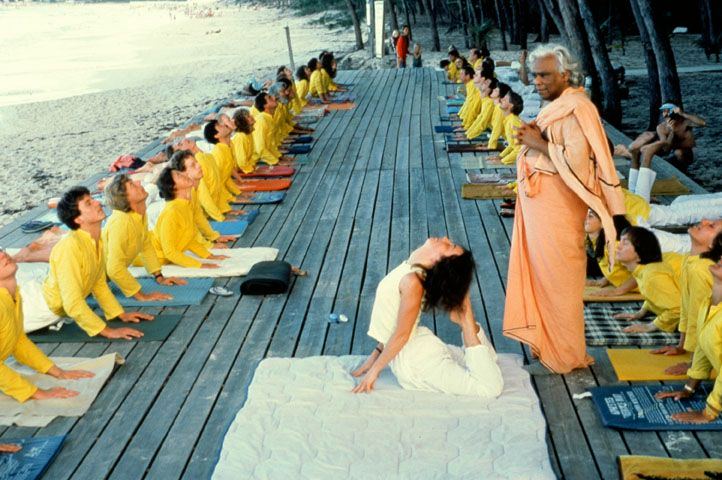
Swami Vishnudevananda teaches a yoga class with many students practicing cobra.
#1 Beginning Prayer and Initial relaxation
Sivananda Yoga classes alway starts with a few minutes of initial relaxation followed by the chanting of 3 OMs and the beginning prayer (Gajananam).
Including prayer before the Yoga session, done mentally or verbally, helps to set the inner mood and create the proper mind set for the practice. The prayers also invoke the Gurus’ and teachers’ blessings for a successful practice.
#2 Pranayama
Pranayama can be performed before or after the session of asanas. For practical reasons, practicing before is better. In fact, pranayama can be performed more than one time throughout a day. In order to practice 15 to 20 minutes is all that is needed.
The 2 basic pranayamas are:
Kapalabhati – (shining skull – forceful breath)
It is said that this pranayama cleanses the lungs and awakens energy. Through this practice all of the old stale air in the lungs is exchanged for new fresh air. We normally practice 3 rounds of 60 – 80 pumping (quick exhalations) followed by breath retention from 45 seconds to 1 minute.
Anuloma Viloma – (alternate nostril breathing)
Anuloma Viloma or alternate nostril breathing is a practice to slow down and manipulate the air flowing in the nostrils. By controlling this air flow we actually start to control the subtle prana and you also control the mind.
In a practice session, we recommend 10 rounds starting on the left and ending on the left side. The count we follow is 4-16-8. Inhale for 4 seconds, retain for 16 seconds, exhale for 8 seconds.
Use the thumb and the ring finger on the right hand to hold the nostrils, and not the index finger. Keep the index finger and the middle finger turned in the palm of the right hand. The sitting posture should stay relaxed and comfortable.
During this practice we keep the breathing even and steady not too fast or too slow. By doing this we regulate the breath and the flow of prana or subtle energy. Additionally, you can focus at the point in between the eyebrows during the practice.
Rest and relax in Savasana for a few minutes after the pranayama session, enjoy the flow of energy.
#3 Surya Namaskar (Sun salutations)
This is a warm up exercises comprising 12 postures, performed continuously without a break, without variations or pauses. Each round is 12 positions. The minimum number of rounds is 8 or better 12.
Every movement is accompanied with the breath. The Sun Salutations can be done slow or fast as desired. All muscles and ligaments are exercised, preparing for the asana session.
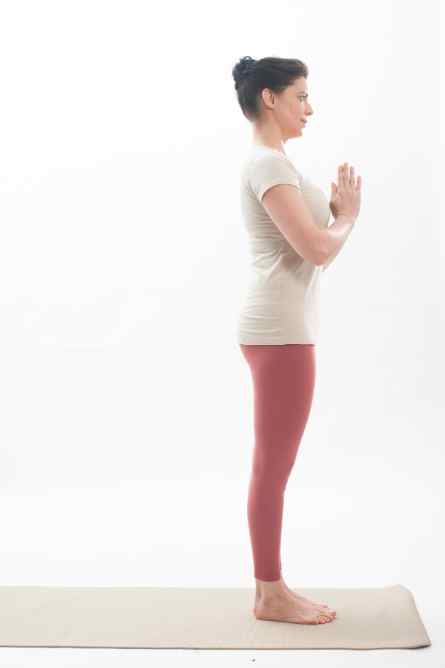
1 - Exhale
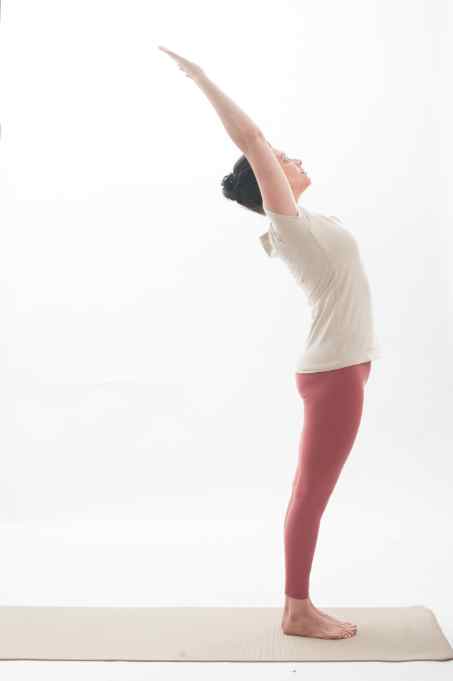
2 - Inhale
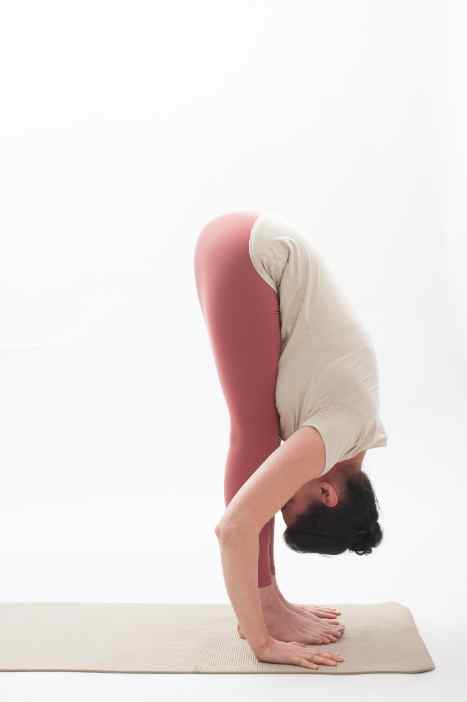
3 - Exhale
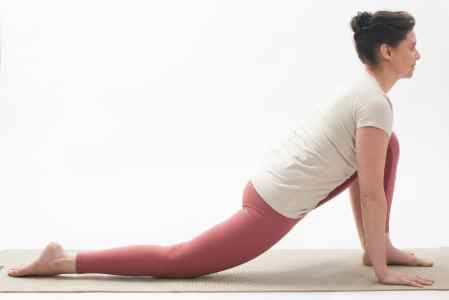
4 - Inhale
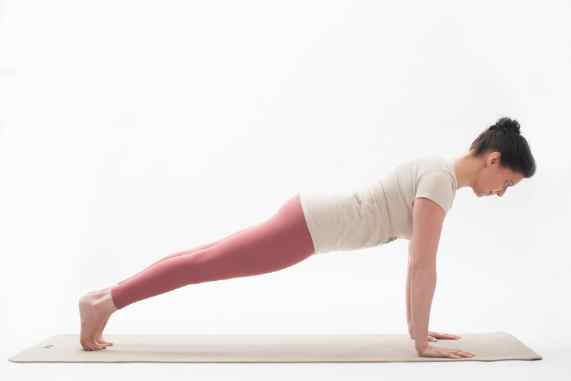
5 - Retain
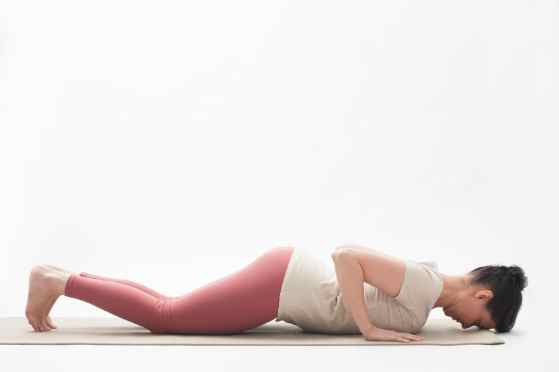
6 - Exhale
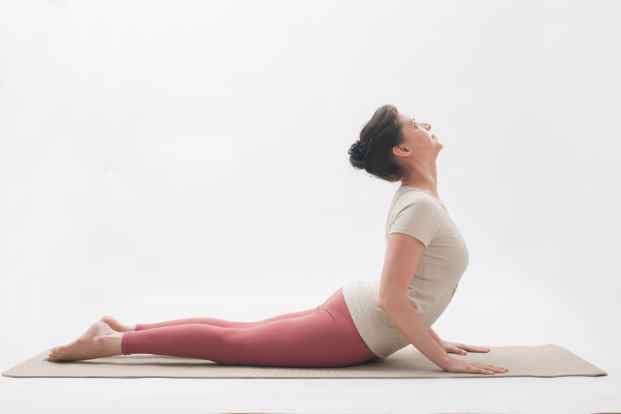
7 - Inhale
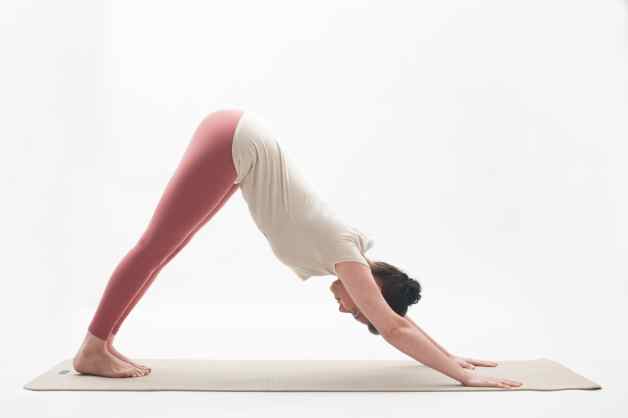
8 - Exhale
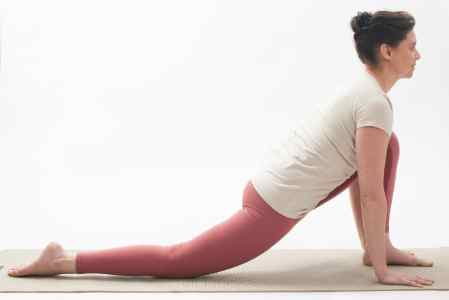
9 - Inhale
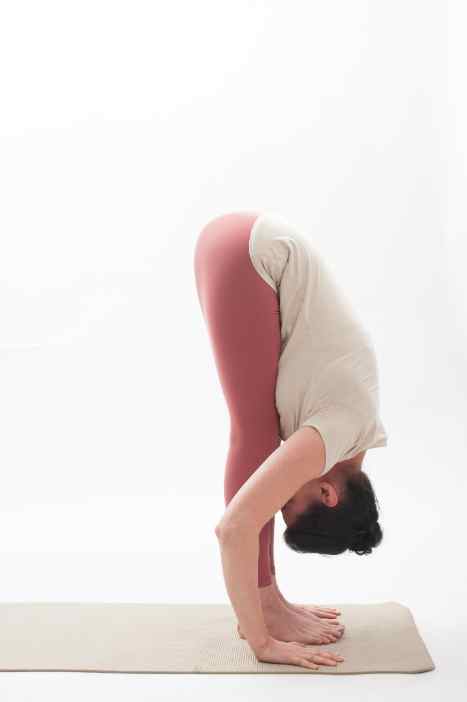
10 - Exhale
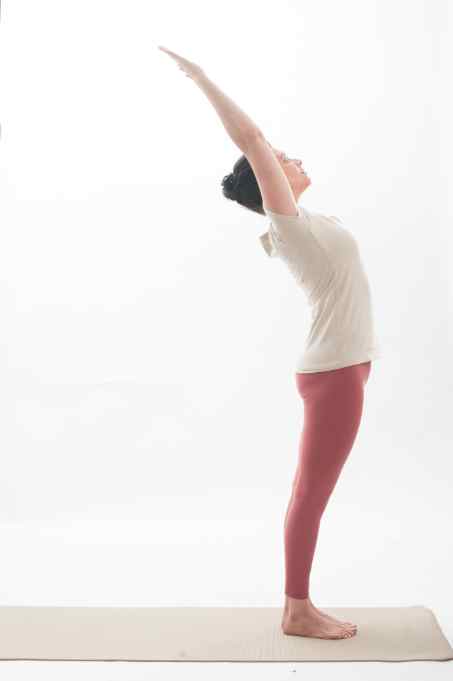
11 - Inhale
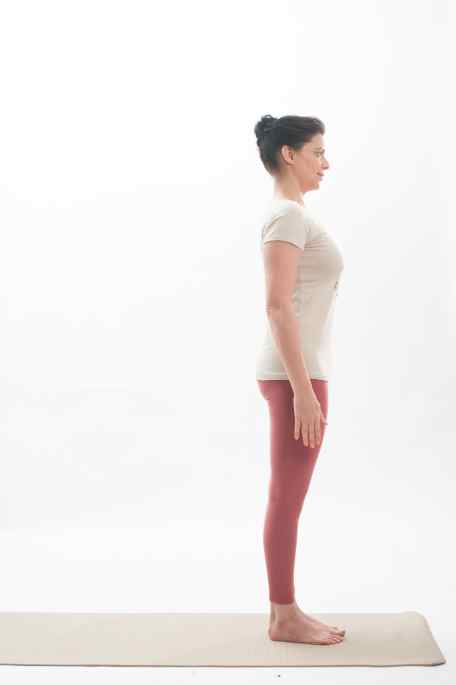
12 - Exhale
#4 The 12 basic yoga poses (asanas)
These 12 basic yoga poses (asanas) in the Sivananda system give you the full benefit of the practice session. Additional yoga poses can be added but the basic 12 yoga poses MUST be included.
#5 Additional Yoga Poses
These are some of the additional yoga poses added to the basic session according to capacity of the student and the time available.
The guideline is that you need to be able to hold the basic posture for three minutes before you start the advanced poses. Please refer to the Section 5a with the sequence of the postures to know in which order to perform them.
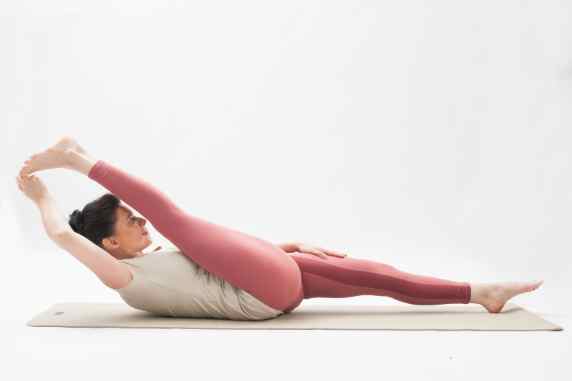
Leg Stretching
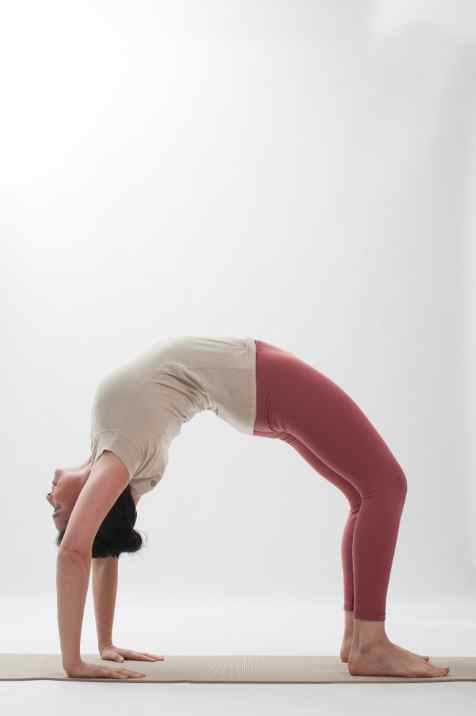
Wheel
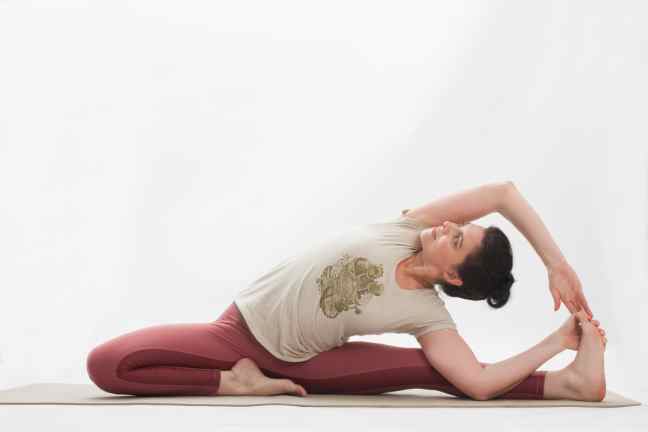
Sitting side stretch
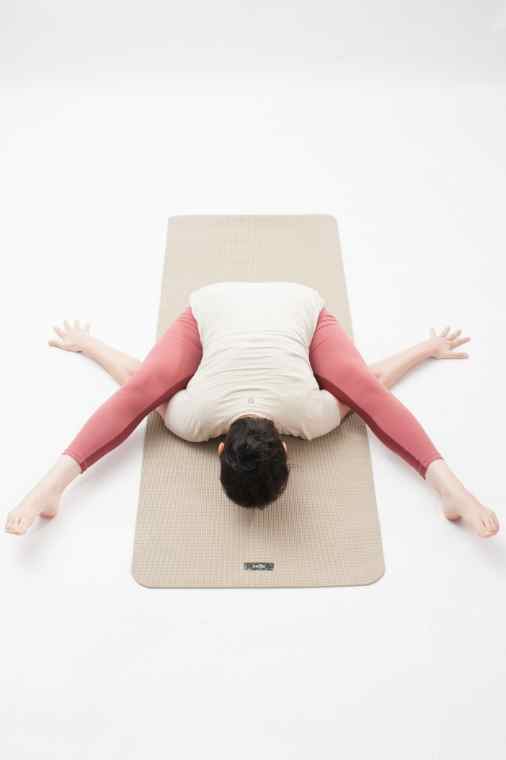
Tortoise Pose
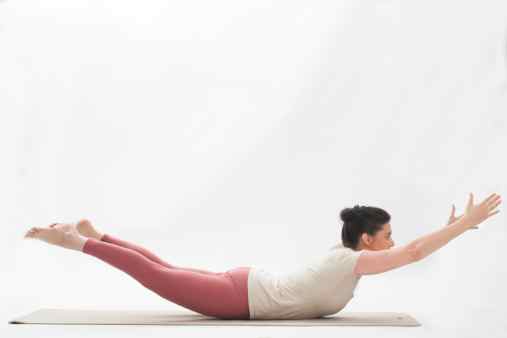
Superman Pose
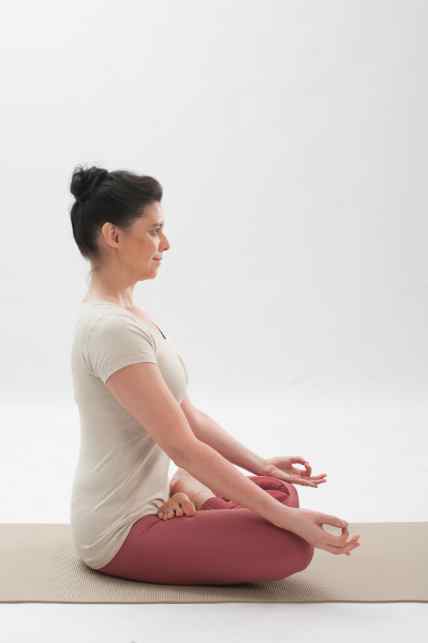
Lotus Pose
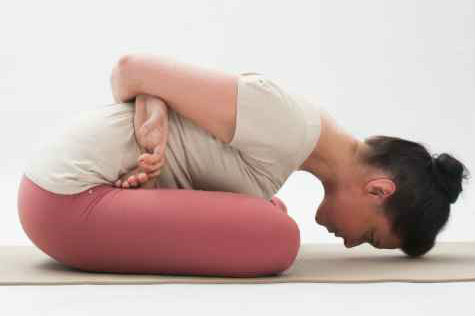
Yoga Mudra
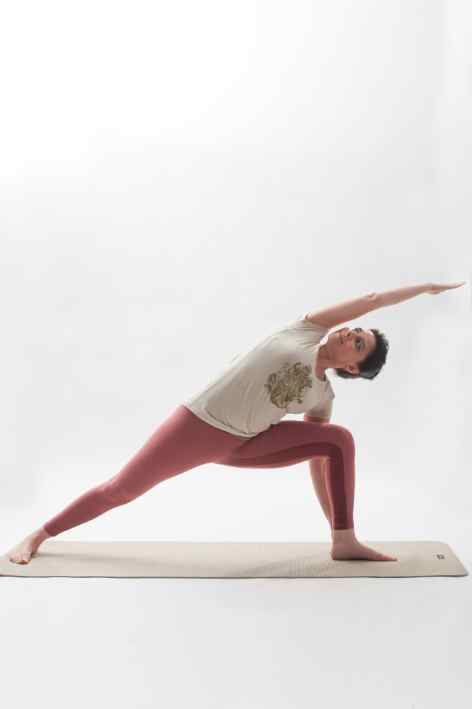
Side Angle Pose
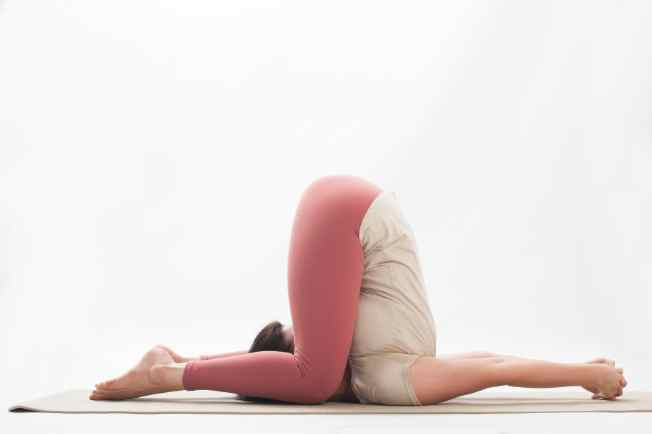
Knees to Ears Pose
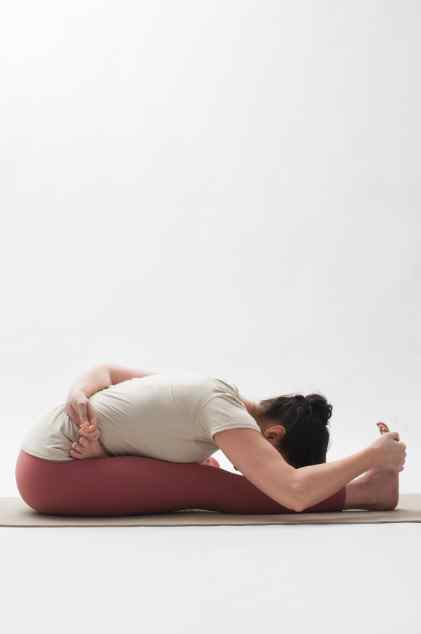
Half lotus forward bend
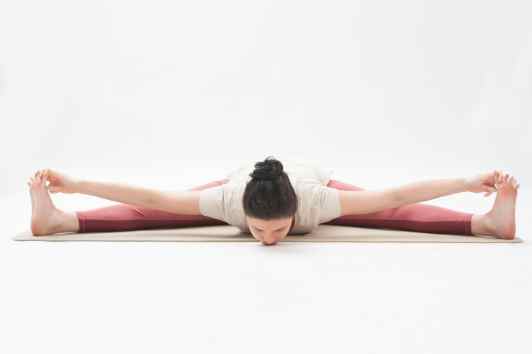
Legs apart forward bend
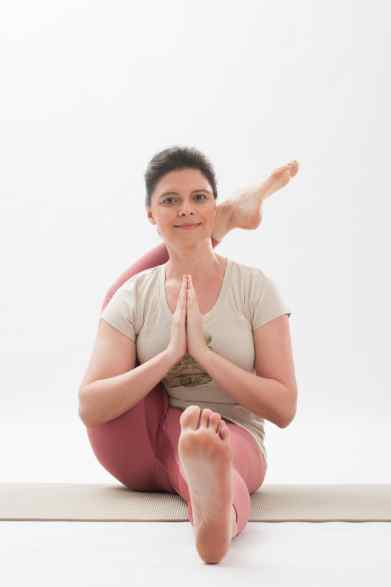
Foot behind head pose
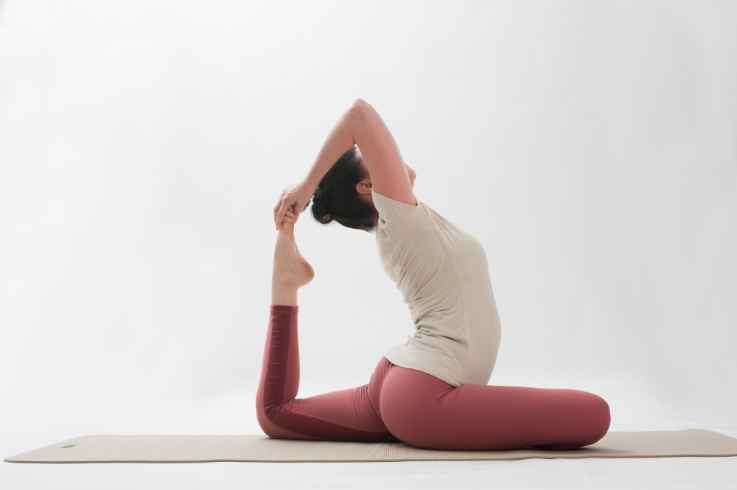
Pigeon Pose
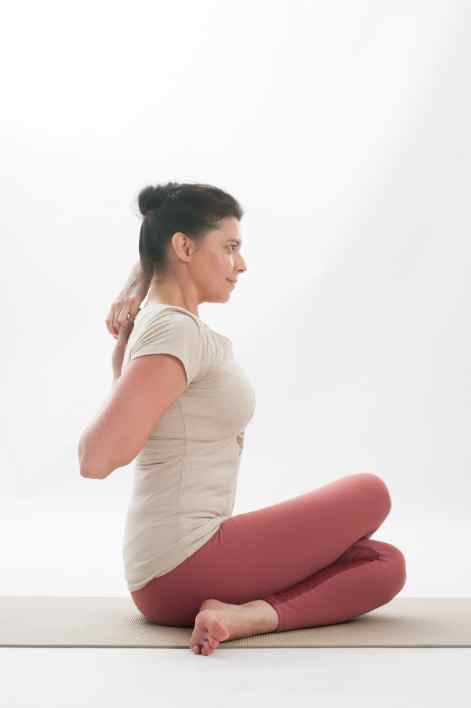
Sitting Warrior pose
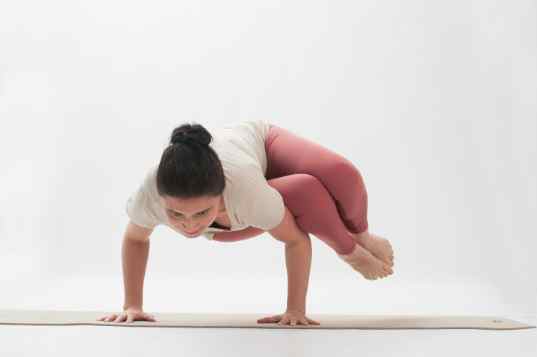
Side Crow Pose
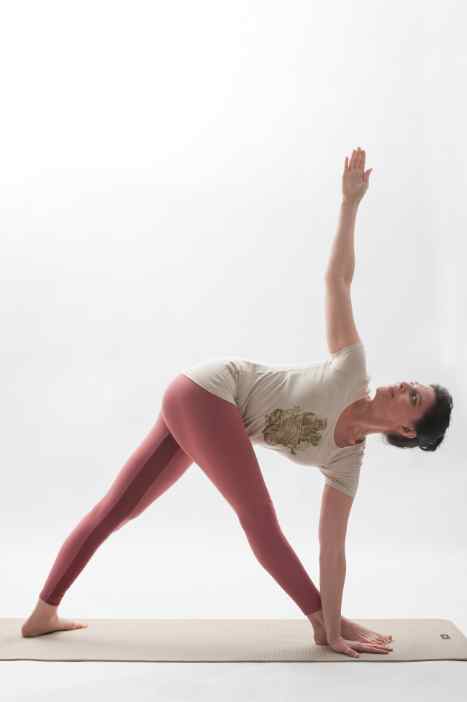
Twisting Triangle
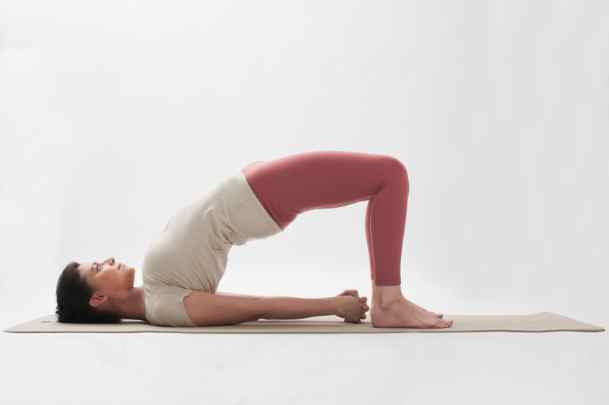
Bridge Pose
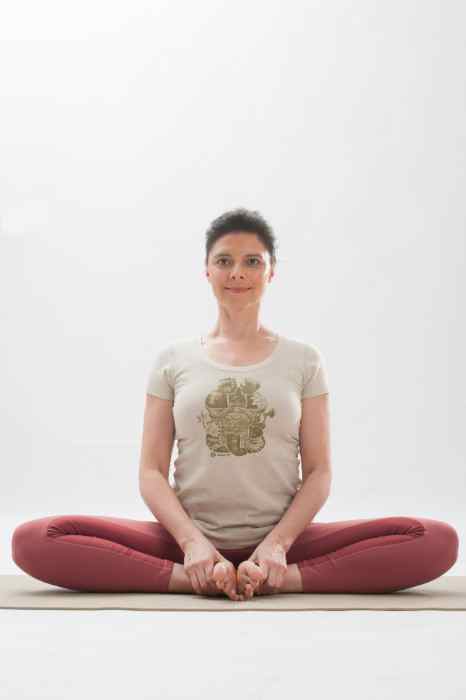
Butterfly
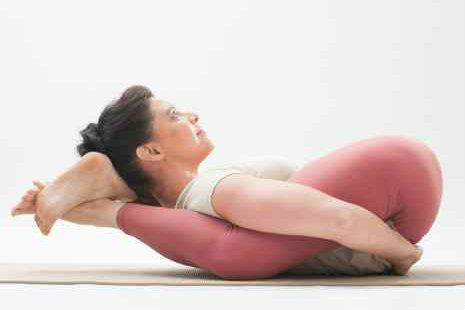
Yogi Sleep Pose
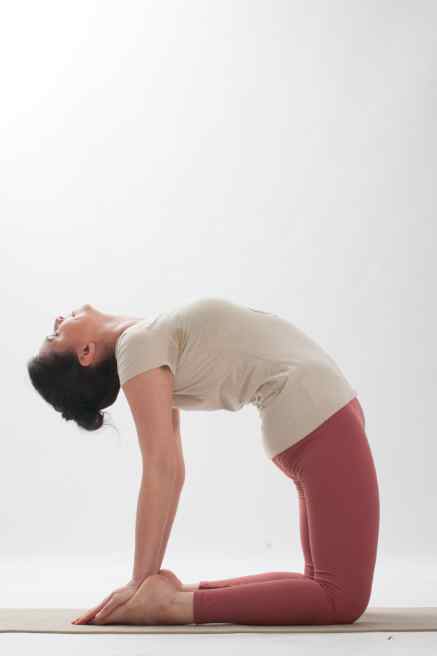
Camel Pose
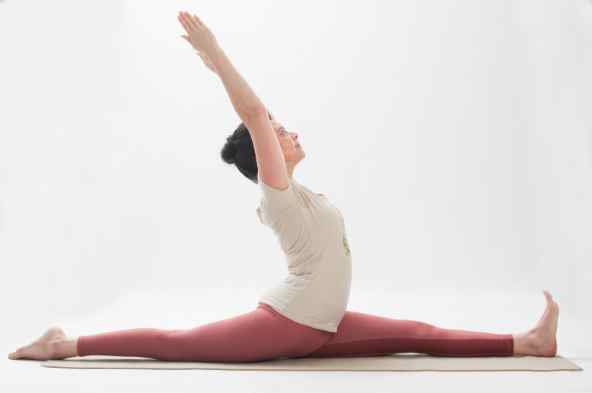
Full Splits Pose
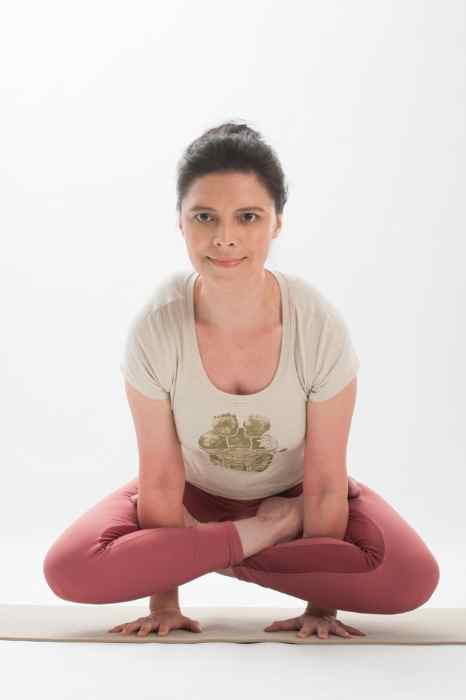
Cock Pose
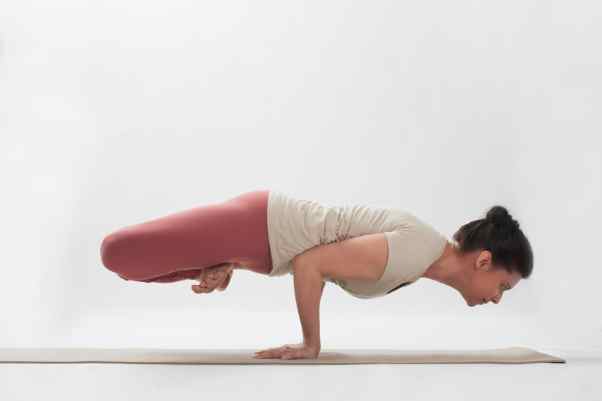
Lotus Peacock
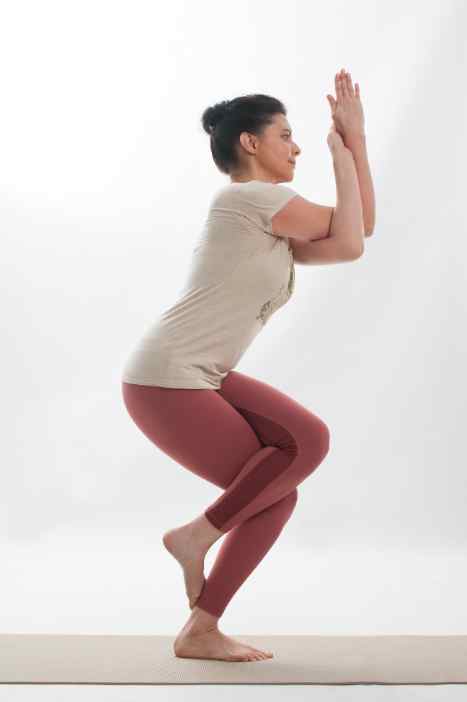
Eagle Pose
# 5a Sequence of Yoga Poses and Variations
This is the structured sequence of a Sivananda yoga class listing basic yoga poses and also the more advanced variations. Sivananda yoga classes must always follow this order. The 12 basic yoga poses are numbered (1) – (12) within each section:
1 – The headstand cycle:
Leg raising exercises and variations
Dolphin exercise for beginners
Half Headstand for beginners
Headstand (1)
Leg variations and arm variations for advanced
Scorpion pose for advanced
2 -The shoulderstand cycle:
Shoulder stand (2)
Candle pose and other variations
Plough pose (3) and variations
Bridge pose and variations
Wheel pose and variations
Fish pose (4) and variations
3 – The Forward bend cycle:
Full seated forward bend (5)
Single leg forward bend
Half lotus forward bend
Butterfy and leg cradling
Tortoise pose
Foot behind the head pose
Inclined plane and variations
4 – The Backward Bend cycle
Cobra pose (6)
King cobra pose for advanced
Half locust and Locust poses (7) and variations
Bow pose (8) and variations
Camel pose
Diamond pose
Crescent moon pose
Pigeon pose
5 – The sitting cycle
Half spinal twist (9)
Lotus pose
Cow face pose
Sitting Warrior pose
Cock pose
Shooting bow pose
Leg behind head pose
Splits and variations for advanced
6 – The balancing cycle
Crow pose (10)
Peacock pose
Handstand
Tree pose
Eagle pose
Nataraja pose
Standing forward bend (11)
Standing Splits and variations for advanced
Triangle (12) and variations
#6 Final Relaxation
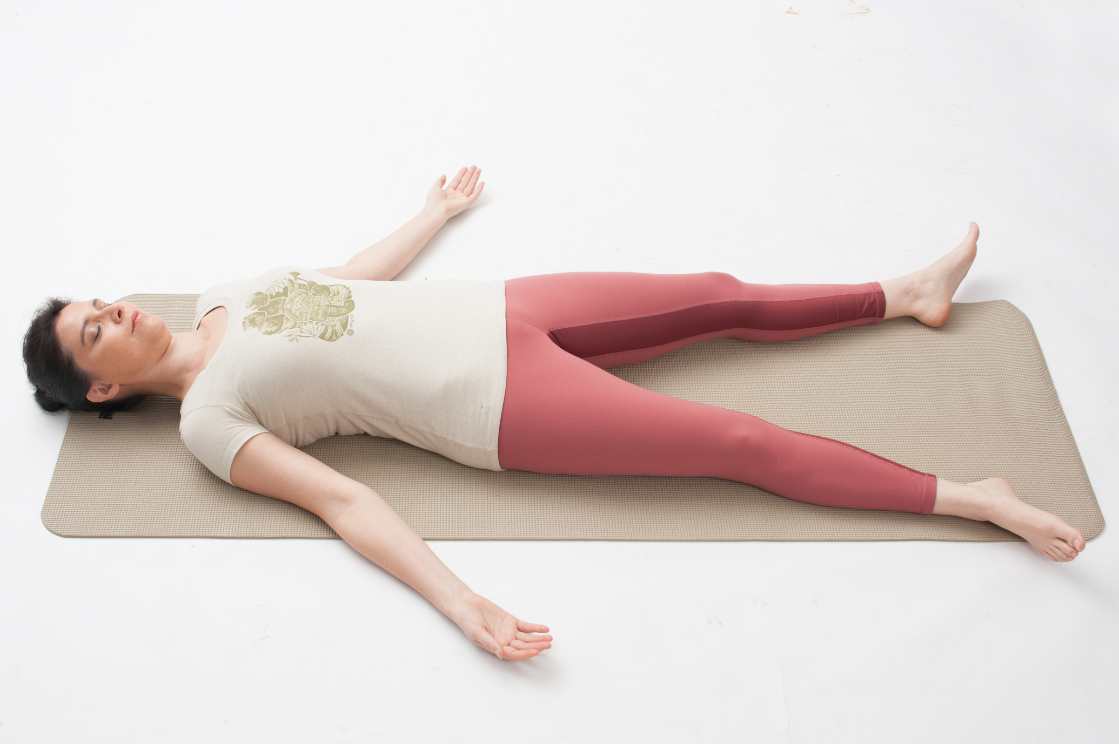
Yoga Pose Savasana or Corpse pose
Lie down with legs and arms open, palms turning up. Breathe rhythmically using the abdominal breath. Systematically, tense each and every muscle from the toe to the top of the head and release them. This tension release exercise helps the flow of prana and induces the muscle to let go of tension.
Use the mind to sweep the body from toe to head, naming consciously each and every muscle or organ, suggesting to them to relax. Allow yourself to let go of the part of the body in question, and return it to nature, releasing your identity and your attachment to it. Additionally, let yourself feel relaxed while resting in your subtle body.
Savasana can be performed many times a day and specially for at least 10 minutes after a Yoga session. It is the most painless and effective method to recharge yourself physically and mentally.
#7 Ending Prayers
End the session with three Om trayambhakam prayers and three Om Shantihs and with pranams and praises to the teachers.
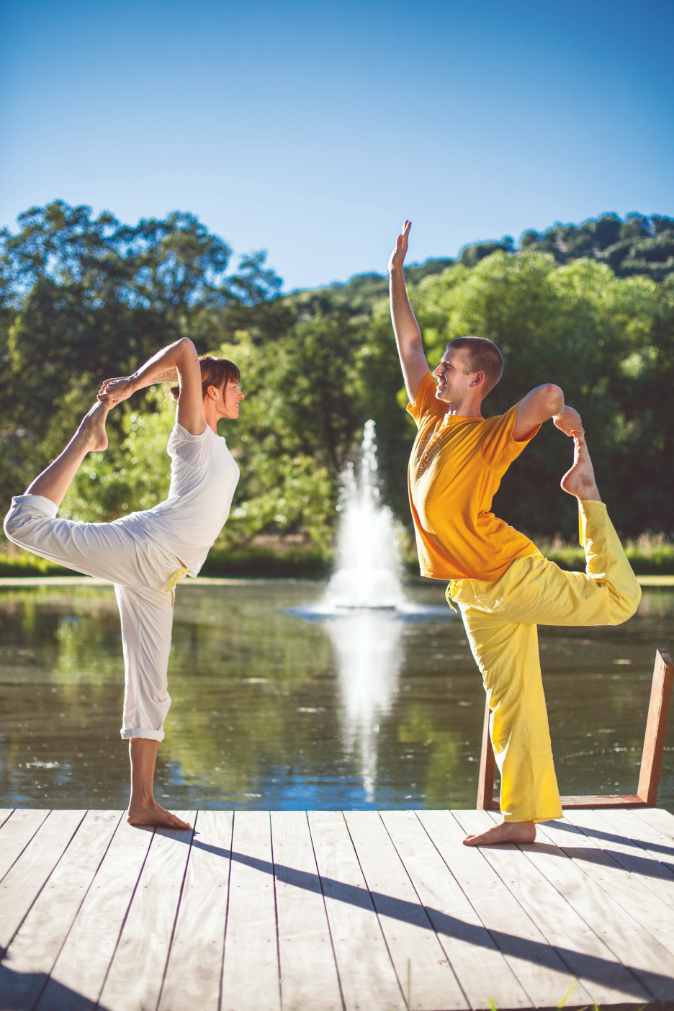
Two students practice the Yoga Pose called Nataraj.
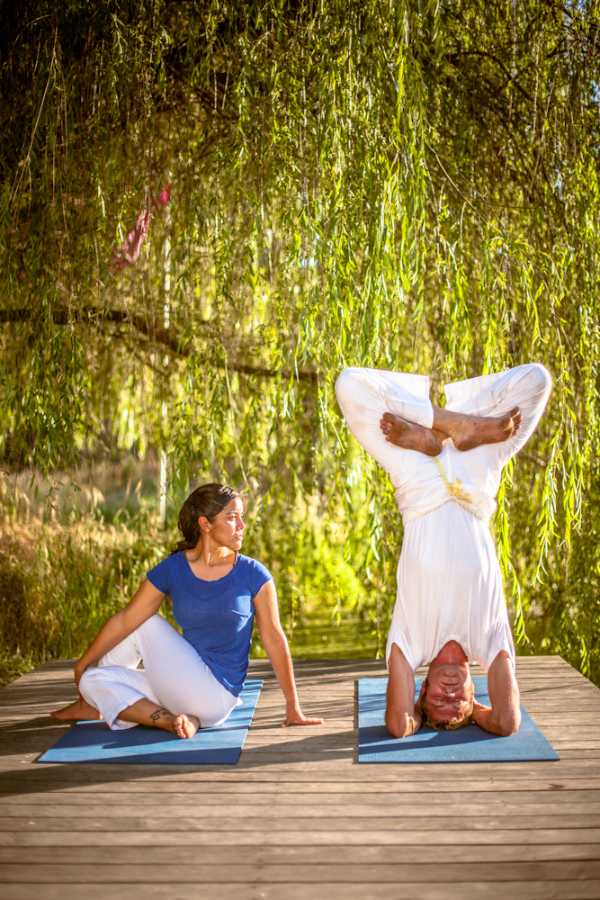
Half spinal twist pose and Lotus Headstand Pose.
General Guidelines
Place & Setting
- Eat at least 2 hours before the asana session. It is difficult to perform asanas with a full stomach. Also, do not eat or drink half an hour after the session.
- The best time is early morning, after meditation.
- Find a cool and ventilated, quiet place with an even, level floor. The best place is a space reserved for Yoga and meditation, with an altar. It is suggested not to do Yoga in the bedroom as the energy is more tamasic.
- It is better to practice in silence without music or chanting.
- Group performance of asanas brings about awareness of collective energy.
- Wear light and loose fitting cotton clothing for better efficiency of movement.
- Use a sticky Yoga mat for better grip.
Order, Timing & Rythm
- Perform the sequence of the postures in order. This will ensure the proper flow of energy.
- Try to hold each posture for at least one minute to three minutes. It is said that holding for three minutes is the minimum time required to get all the benefits of the postures.
- The sequence of the postures follows the chakras, stimulating the chakras from the top down.
- The headstand cycle goes first and the standing cycle goes last because of the spiritual principle of turning inward first to find inner balance (headstand inverts all energies, stimulating the highest chakra, going against normal tendencies, after which the energy is flowing properly) then tuning the mind outward and trying to achieve balance and composition with worldly activities (standing postures are performed with the focus on external object to ground oneself).
- Practice daily, or at least 4 times a week, for 1-2 hours for maximum benefit.
Breath & Mind Awareness
- Breathe consciously during the performance of postures. When holding the posture, the breath becomes calm and the mind focused.
- When holding, know where to concentrate for the specific posture.
- If there is tension, focus your attention on the tension, breathe consciously while focusing on the area, sending prana to the muscles or ligaments, and during every exhalation try to progress a little more.
- Keep the mind inspired by being aware of the physical and mental benefits of each posture.
- Yoga is not a competition, so try to do what you can but observe your limit. Always try to feel comfortable. Never push yourself to the point of pain, strain or exhaustion.
- Do not compare or compete with each other when perform in group.
Body Awareness
- Gentle modifications, adjustments and variations can be included if you experience any pain or strain while holding an asana. Some accessible examples include chair yoga, gentle yoga and restorative yoga. Click here to learn more about specialized yoga practices.
- Be aware of your body throughout the session. Keep your mind focused inward and enjoy the practice.
- Always relax in between the postures, with deep breathing to restore the prana and avoid fatigue.
- If there is no time, stick to the basic 12 postures without variations, you will still get the maximum benefit.
Asana Considerations
- For beginners, take the time to practice headstand by preparing your arm strength with Dolphin.
- Achieve balance through posture and counter posture, on both the right and left sides, holding the postures on each side for an equal length of time.
- If you do variations, make sure that you have time for the basic postures first. Do not skip postures.
- Try to practice asanas with eyes closed, creating an inner focus.
- If possible, it is better to perform the asanas without any props. It is a very natural way of exercising.
- To maximize the benefit of the session, keep the energy internalized and calm and do not rush right away into worldly activities.
- Always spend at least 10 minutes in Savasana at the end; it allows you to integrate all of the benefits.
- Do not take a bath right away but allow the prana to remain for some time.
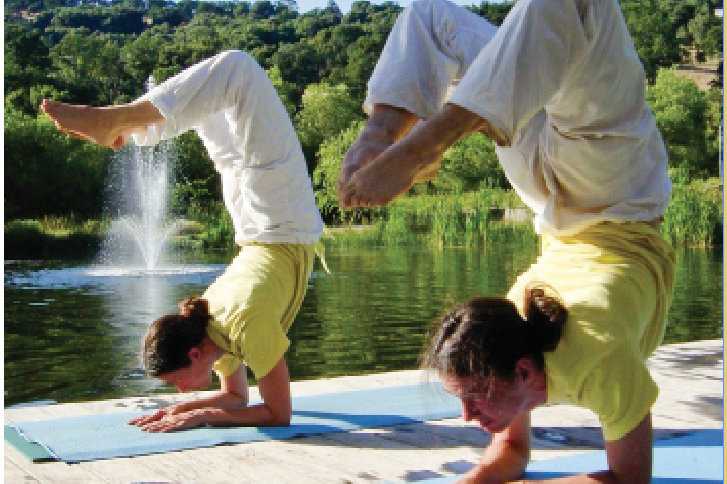
Two students practice the scorpion pose.
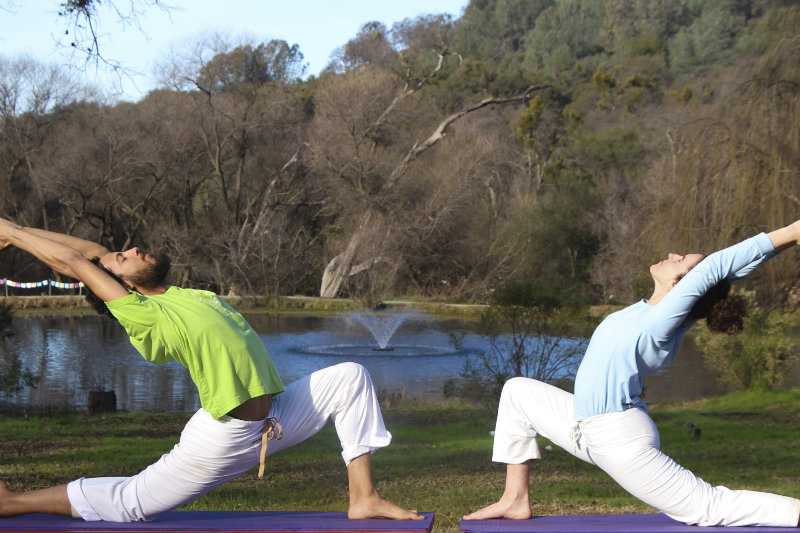
Two students practice the crescent moon pose.
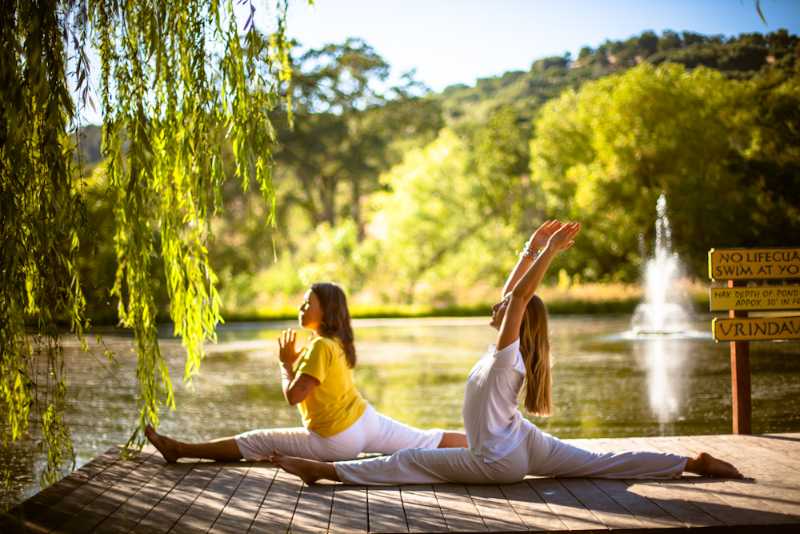
Two students practice the full splits yoga pose.
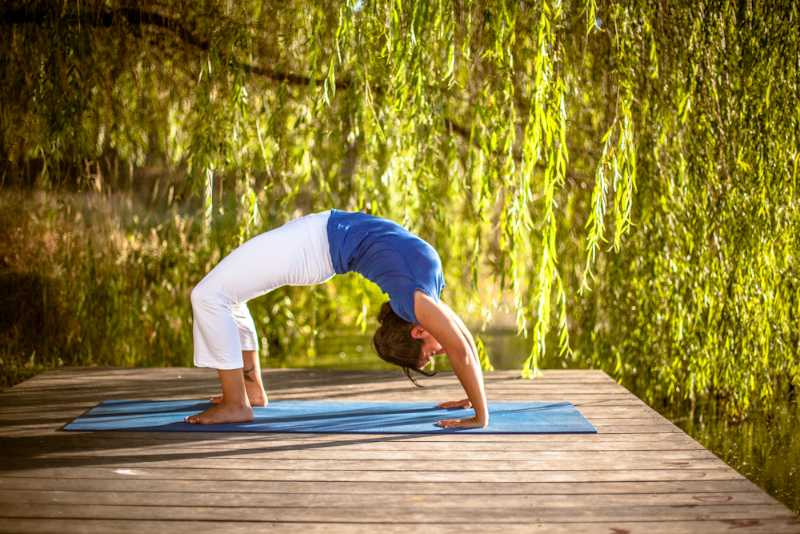
Wheel pose also called Chakrasana.
Benefits of Pranayama and the 12 basic yoga poses
There are numerous benefits to a regular yoga practice physically, mentally, emotionally, and spiritually. Some of the most important benefits are listed out below.
KAPALABHATI (Cleansing Breathing Exercises)
- Cleanses the nasal passages and the entire respiratory system.
- Strengthens and increases the capacity of the lungs and the ribcage muscles.
- Helps to drain the sinuses and eliminates excess mucus.
- Removes bronchial congestion.
- Eliminates excess carbon dioxide, permitting red-blood cells to take more oxygen.
- Refreshes and invigorates the mind, increasing alertness.
- Stores prana (vital energy) in the solar plexus (navel) region.
ANULOMA VILOMA (Alternate Nostril Breathing)
- Cleanses and strengthens the entire respiratory system.
- Harmonizes the entire system and calms the mind.
- Increases the flow of oxygen from the lungs to the blood and enables more carbon dioxide (and other waste) to pass from the blood to the lungs for elimination during exhalation.
SURYA NAMASKAR (The Sun Salutation)
- Makes the spine flexible. Stretches and strengthens all the major muscle groups of the body.
- Improves intake and flow of oxygen, stimulating the respiratory system and bringing increased blood flow, warmth and energy to the whole body.
- Relaxes the nerves, regulates breathing and focuses the mind.
SIRSHASANA (The Headstand)
- Strengthens the respiratory and circulatory systems.
- Increases oxygen supply to the brain and sympathetic nervous system, improving memory and concentration.
- Relives pressure on the lower back and aligns the spine.
- Stimulates the pineal and pituitary glands.
- Relieves varicose veins (as does the shoulderstand)
- Counteracts nervous disorders and anxiety.
- Considered a panacea for overall health and vitality.
SARVANGASANA (The Shoulderstand)
- Regulates the thyroid gland. Improves metabolism and heat production and proper growth of muscle and bone.
- Benefits heart rate, heart contractibility and blood pressure.
- Stimulates and regulates the parathyroid gland which helps to maintain proper calcium levels in the body.
- Keeps the neck and spine strong and elastic
- Prevents blood from stagnating in the veins of the lower limbs.
- Removes mental sluggishness, insomnia and depression.
HALASANA (The Plough)
- Increases flexibility in the neck and spine and opens up the spinal discs, rejuvenating the entire spine.
- Nourishes the spinal nerves.
- Strengthens muscles of the back, shoulders, and arms.
- Massages the internal organs.
- Relieves indigestion and constipation.
MATSYASANA (The Fish)
- Removes stiffness from the entire length of the spine, bringing increased blood supply to the back.
- Corrects round shoulders.
- Stimulates the pituitary and pineal glands.
- Regulates mood, emotions, and stress.
- Increases lung capacity, strengthens and cleanses the respiratory system. Relieves asthma.
- Stimulates and massages the parathyroid glands in the back of the neck, which protects bones and teeth.
PASCHIMOTHASANA (The Sitting Forward Bend)
- Stimulates digestive organs. Increases digestive fire.
- Invigorates all internal organs; reduces body fat.
- Regulates the pancreas, which controls carbohydrate metabolism and blood sugar levels
- Mobilizes joints, especially the hips.
- Invigorates the entire nervous system.
- Alleviates disorders on the urinal-genital system.
BHUJANGASANA (The Cobra)
- Massages and stretches deep and superficial back muscles.
- Increases flexibility of the spine.
- Relieves hunchback, back pain and lumbago.
- Tones the abdominal organs, ovaries, uterus and adrenal glands.
SALABHASANA (The Locust)
- Strengthens the abdominal wall and lumbar muscles.
- Improves digestion. Massages the pancreas, liver, and kidneys.
- Promotes flexibility of the cervical region of the back.
- Strengthens the biceps, deltoid muscles and back.
- Reduces lower back pain and sciatica.
- Increases space between the vertebrae.
DHANURASANA (The Bow)
- Promotes flexibility of the entire spine.
- Invigorates and massages the digestive organs.
- Alleviates constipation and indigestion.
- Regulates the pancreas.
- Prevents ossification of the bones.
- Strengthens the abdominal muscles.
- Prevents rheumatism of the legs, knees, and hands.
ARDHA MATSYENDRASANA (The Half Spinal Twist)
- Keeps the spine elastic.
- Increases synovial fluid of the joints.
- Stimulates glucose release. Tones the sweat glands.
- Massages the abdominal muscles and digestive organs.
- Relieves constipation and other digestive problems.
- Tones and stimulates the sympathetic nervous system.
- Regulates the secretion of adrenaline and bile.
- Corrects stooping shoulders and poor posture.
KAKASANA (The Crow)
- Strengthens and stretches the hands, arms, wrists, and shoulders.
- Increases breathing capacity
- Promotes physical and mental balance.
- Increases power of concentration.
- Removes lethargy.
PADA HASTASANA (The Standing Forward Bend)
- Lengthens the spine and makes it supple.
- Mobilizes the joints and invigorates the entire nervous system.
- Increases the blood supply to the brain.
- Decreases abdominal fat.
- Relieves sciatica and low back pain.
TRIKONASANA (The Triangle)
- Tones of the spinal nerves and abdominal organs.
- Promotes hip and leg flexibility.
- Strengthens the pelvic area.
- Massages and stimulates the liver and spleen..
SAVASANA (The Relaxation Posture)
- Allows the body and mind to rest and recharge.
- Distributes prana throughout the body.
- Enables the benefits of the asanas to be assimilated.
- Facilitates the elimination of toxins.
Yoga Teacher Training Course
Check out our 200-hour Yoga Alliance certified Yoga Teacher Training Courses offered twice a year in California, 3x in Vietnam, once in China and once in Japan.
Foundational Courses
Choose from upcoming courses for beginners and intermediate level students.
Yoga Vacation
Rejuvinate your body and mind. Experience and progress with daily Yoga classes. Learn the 12 basic asanas and pranayama. Enjoy daily meditation, chanting, and organic vegetarian meals.
Check out our Blog
Our Sivananda Yoga Farm Blog has numerous articles, videos, and talks given by our senior teachers over the years.
OUR TEACHINGS
The contents you will find here are reproduced from the book “Essentials of Yoga Practice and Philosophy” compiled by Swami Sitaramananda.
Satsang
What is Satsang? What is Meditation? What is Kirtan Chanting?
5 Points of Yoga
Exercise, Breathing, Relaxation, Diet, Positive thinking and Meditation
Health
What is True Health? What is health of body, mind, and spirit?
Prana
What is Prana? How can I access prana? What is kundalini energy?
Raja Yoga
What is Raja Yoga? What are the eight limbs? What is ashtanga yoga?
Jnana Yoga
Who am I? What is Vedanta Philosophy? What is Sat-Chit-Ananda?
Mantras
What is a mantra? What is sanskrit? How do I get a mantra?
Yoga Poses
What is in a basic Sivananda class? What are the benefits? What are some guidelines?
Yoga
What is Yoga? Where did Yoga come from? What is Classical Yoga?
Life
What is the meaning of Life? What is Freedom? What is Happiness?
Mind
What is the mind? How does the mind work? Am I my mind?
Positive Thinking
What is thought? What are techniques to practice positive thinking?
Karma Yoga
What is Karma? What is Karma Yoga? How to practice karma yoga?
Bhakti Yoga
What is True Love? Who is God? What is an inner Bhava?
Kirtan Chanting
What is Kirtan Chanting? How does it work? What do the chants mean?
Ayurveda
What is ayurveda? What are the 3 doshas? What is disease according to ayurveda?
